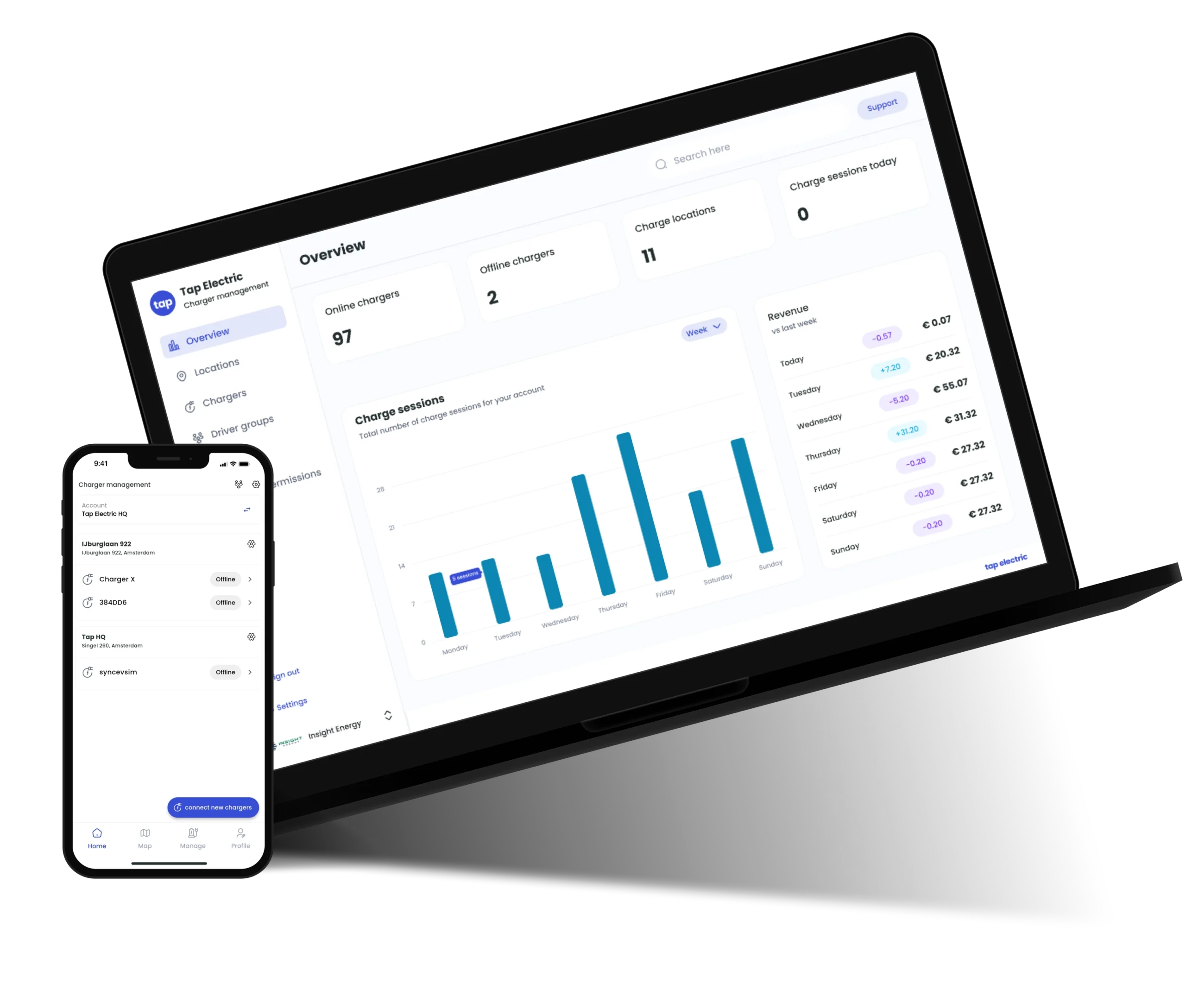Summary
Roaming makes it easier for drivers to use EV charging stations across different networks with a single app or charge card.
- Convenience for drivers: More accessibility and choice on where to charge.
- Increased utilization: Charger owners see more usage of their chargers by opening up to roaming.
- Brand visibility: Roaming enhances brand awareness as charger details are displayed across networks.
- Potential downsides: Risks include loss of pricing control and possible non-payment by MSPs.
- Overall benefit: Despite some risks, roaming is a key feature that benefits both drivers and charger owners in the EV ecosystem.
What is roaming in EV charging?
The public car charging ecosystem can be split into two distinct responsibilities: managing chargers, and facilitating payment transactions. Sometimes these roles are handled by one party; for example, when you use Apple Pay to charge at Fastned. Fastned handles the payment directly and activates the charger.
When the car charging market was in its infancy (as it happens, in The Netherlands), it was recognized that many early EVs would be leased cars, where employees would want to use a payment method that automatically billed their employer. Dutch employees usually have no company credit cards, but they do often have a fuel card. The EV charge card, and thus roaming, was born.
Charge cards would be issued and managed by Mobility Service Providers (MSPs). Chargers would be managed by Charge Point Operators (CPOs). To allow their drivers to charge on the CPO’s chargers, the MSP needs to set up an agreement with the CPO. The MSP sends the CPO a list of driver IDs that it should accept, and the CPO sends the MSP bills for all charging sessions that were done by the MSP’s drivers.
The cost that the CPO bills the MSP is called the wholesale cost. CPOs can make money via the difference between wholesale (revenue) and their cost of electricity. The MSP can then individually bill each driver or their employers. The cost that the MSP charges the driver is called the retail cost. MSPs can make money via a margin between retail (revenue) and wholesale (cost) and/or by a subscription fee.
Roaming is all about the “interoperability” between different parties in the market.
Why is roaming important for drivers?
There are thousands – that’s right, thousands – of branded CPOs throughout Europe and the UK. Roaming on the public charging network is thus the single biggest factor in ensuring a uniform payments experience for drivers. It ensures that with a single app or charge card, drivers can access hundreds of thousands of chargers without having to worry about figuring out how to pay for them.
“But why don’t all chargers just have a contactless payment terminal on them?” This is a valid question, with 2 main answers:
1. Contactless payments are more expensive than roaming.
Contactless payment terminals are relatively expensive to install and operate, and in many cases can kill the business case on a charger.
To start, a contactless terminal can cost between 500 to 1000 euros or pounds.
They can then cost around 200 euros/pounds to operate each year in fixed costs.
Terminals then apply a very expensive payment processor taking transaction fees in the order of 2-3%.
Finally, terminals are another connected device that can malfunction, break, or be vandalised, leading to repair and replacement costs.
On a DC fast charger that is seeing constant turnover and high value transactions, contactless terminals make lots of sense. On an AC charger, that on average sees a few sessions per week at a tariff of 0.30/kWh, the economics simply do not work.
In this case, roaming is the perfect solution – it has near-zero marginal cost and gives a simple payments experience to the driver.
2. Fleets rely on charge cards, not contactless payments
As we touched on earlier, fleet drivers need a way they can easily get their fuel costs to their employers, without the burden of filing expense reports from credit cards.
Roaming provides the perfect solution here, as employers receive a single bill from their MSP detailing all transactions across different CPOs.
Beyond the practicalities described above, roaming can bring even more value to drivers. These days, a lot of charging session starts come from charging apps like Tap Electric. While CPOs tend to be focused on installing and maintaining hardware, MSPs tend to be focused on user experience and added-value services for drivers.
For example, with the Tap Electric app, you get:
- More security than a standard RFID card, with the only 2FA enabled card on the market
- Pricing breakdowns and comparisons
- Trip planning and reliability scoring
- Information about power restrictions and charging schedules
These features are delivered uniformly across the entire roaming network, which makes a driver’s charging journey orders of magnitude simpler.

How does roaming benefit charger owners?
There are several reasons why charger owners should consider opening their chargers for roaming.
1. Improved driver experience.
Drivers can start sessions on your chargers using their preferred MSP, either by charge card or with an app that they are familiar and comfortable with. No worrying about scanning a QR sticker, downloading a new app, etc.
2. Increased utilisation.
Tap is connected to every major MSP in your market – that’s millions of private and fleet drivers who can now all access your chargers! If you want to drive maximum revenue through your chargers, roaming is a great way to accomplish this.
3. Brand awareness.
Since your brand information is passed through to MSPs when you open up for roaming, they display this branding to their drivers, often in their map.
Are there any downsides to roaming for charger owners?
While roaming is largely beneficial for charger owners, there are a couple of potential downsides to be aware of.
1. You don’t control the final price.
While many MSPs work on a “cost plus” model, where they simply pass the cost of the CPO to the driver with a small markup, there are exceptions.
Some MSPs offer a “fixed price” model, where they charge the same price at every CPO. This can result in a great deal on expensive chargers, and a huge rip off on cheaper chargers. Therefore, if you are trying to entice drivers to your location with affordable charging, that benefit not might always make it to the driver.
2. Risk of non-payment by MSPs.
Like any business, if a customer doesn’t pay, you can end up out of pocket. In the case of MSPs, since they are aggregating large numbers of drivers, a late or unpaid invoice can have an impact on your business.
Conclusion
Roaming plays a crucial role in enhancing the EV charging experience for both drivers and charger owners. For drivers, it offers convenience, accessibility, and a seamless payment process across a wide network of charging stations, making their journeys less stressful and more efficient. Charger owners benefit from increased utilization, brand visibility, and the ability to cater to a broader customer base. While there are some potential downsides, such as loss of control over final pricing and the risk of non-payment by MSPs, the advantages of enabling roaming generally outweigh these concerns. By embracing roaming, the EV charging ecosystem can continue to grow and evolve, making electric vehicle adoption easier and more appealing for everyone.

Try the app
Manage your chargers for free
Tap does not charge any monthly licence or startup fees. We charge a service fee to the driver, and that’s it.
